Stem cell transplants offer hope for sufferers of gut disorders

After a baby is born, a souvenir of its months in the womb is usually not long to follow. Its first poo, or meconium, is a lump sum of everything the foetus has ingested for months; a dark sludge, compared by the insomniac readers of parenting forums to engine oil or tar.
That first stool is probably the ground zero for Dad jokes. But if it hasn't emerged after 48-72 hours, doctors know to start looking for Hirschsprung Disease. Although rare, affecting one in 5000 live births, Hirschsprung's effects can be debilitating and lifelong, including bowel obstructions, constipation, reflux and vomiting.
"The muscles in the gut wall of these babies are not doing their job, which is to push food through the intestines, because the gut nerves are missing. The milk accumulates, their bellies get distended and the effect is like blocking the end of a fire hose," says developmental neurobiologist Professor Heather Young, of the University of Melbourne.
Professor Young's lab is exploring the potential for stem cell transplants to treat Hirschsprung's Disease, and other disorders of the gut's nervous system. In a recently published article, the team extracted stem cells from healthy parts of the bowel, grew them in a dish (these tiny balls, called neurospheres, measure one fifth of a millimetre, requiring some very fine forceps), and transplanted them back into sections of the gut wall that are missing neurons in Hirschsprung disease.
Currently, the only treatment for Hirschsprung's is surgery, which, while lifesaving, is usually followed by complications and psychosocial issues from problems such as soiling.
"For kids with the most severe form of the disease, life is really tough. They're on a feeding tube and total parenteral (intravenous) nutrition for the rest of their lives," Professor Young says.
The research team, based at the University, the Florey Institute and Queen's University in Canada, is investigating what happens when the development of the gut nerves, or enteric nervous system, is derailed, causing disorders like Hirschsprung's. Often called the 'second brain', this extensive network of 500 million neurons (five times the number of neurons in the spinal cord) controls digestion and excretion.
Our gut neurons are responsible for gut motility, or peristalsis – the muscular spasms that push food from the stomach, into the intestines and out through the anus. And researchers are now also exploring its influence on mood and behaviour, and links with conditions such as autism and even some forms of epilepsy. .
When things go well, the enteric nervous system rumbles away in the background, beyond conscious control or awareness (barring the odd tummy ache). But when things go awry, the effects can be devastating.

The gut odyssey
Like all epic stories, the story of the gut nervous system begins with a massive migration.
Gut neurons start life as stem cells located near the base of the developing brain. Making their way from the neural tube into the developing gut tube, they then colonise the entire gastrointestinal tract. Once there, many of them differentiate into nerve cells that make the muscles in the gut wall relax, while some differentiate into nerve cells that are responsible for contractions. Others, known as interneurons, are the middlemen that connect those movements into a rhythm.
"Think of the East coast of Australia as the gastrointestinal tract, with Cairns the oesophagus and Melbourne the . . .ahem . . .other end," explains Lincon Stamp, from Prof Young's laboratory.
"Imagine people migrating down the coast in their cars, all from top to bottom. Normally some make it all the way to Melbourne, with others stopping off to set up homes in cities along the way. However, sometimes the people destined for Melbourne run out of fuel and are stranded further up the coast.
"In Hirschsprung disease this is due to genetic defects – some random, some inherited – which cause the migrating cells to run out of fuel, leaving them stranded and the last part of the bowel unoccupied."
Most infants are diagnosed with Hirschsprung before they leave hospital, but if only a small region of the bowel is affected, the condition might not be picked up for weeks or months. Surgeons will often remove the affected section of bowel and reattach what's left.
"When neurons in your bowel are diseased or damaged, they're really challenging conditions for gastroenterologists to treat. There are currently no drug treatments," says Dr Stamp.
Gut motility disorders also strike later in life, but these ones tend to affect specific subpopulations of nerves – much as Parkinson's disease affects a specific type of brain neuron. By contrast, childhood disorders are usually defined by a total absence of neurons in sections of the bowel or the entire organ.
One increasingly common adult condition is gastroparesis, which is associated with uncontrolled diabetes, Parkinson's disease, and MS. Another is achalasia, characterised by the loss of neurons that enable the sphincter to open and close the oesophagus. It mainly affects elderly people, and is a kind of mirror image to the popular complaint of gastrointestinal reflux, where stomach acid leaks out and up from the oesophagus. Only in achalasia, the oesophagus fails to open at all.
"They can't swallow solids – they end up living on soup and liquids. They can choke because the sphincter is not opening," Professor Young says.
Completing the migration
The work by Lincon Stamp and his team on an animal model of Hirschsprung disease is essentially about completing that disrupted migratory journey of stem cells from the brain to the bowel.
"We've shown that they migrate and colonise a reasonably good area of the bowel after the transplant," says Dr Stamp.
"We've been able to transplant cells that survive four months, while another group in the UK has achieved 24 months."
The transplanted cells not only survive – they look and behave like neurons.
"Stem cell therapy for a gut motility disorder requires neurons that don't just fire – they have to connect with the muscle in the gut wall, to control the relaxation and contractions that move food through," Dr Stamp says.
A new technique called optogenetics enabled the team to confirm the transplanted neurons were behaving as they should. Optogenetics involves inserting light-sensitive proteins, derived from green algae and called opsins, into neurons. The opsins activate the neurons. The team recorded the results to check for signals from the muscles. (Before opsins came on the scene around 2008, neuroscientists could only use electrodes to control neurons).
One of the challenges for the Young lab is isolating gut stem cells in humans and gathering them in sufficient numbers for transplantation. One UK lab has developed technique to make this much easier via routine endoscopies, opening the way to future patient-derived stem cell treatments.
"While a stem cell therapy for humans with gut motility disorders is likely still years away, this study is an exciting leap forward in progress toward that goal," Dr Stamp said.
More information: Lincon A. Stamp et al. Optogenetic Demonstration of Functional Innervation of Mouse Colon by Neurons Derived From Transplanted Neural Cells, Gastroenterology (2017). DOI: 10.1053/j.gastro.2017.01.005















